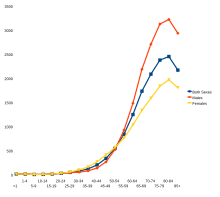
Back أمراض مصاحبة للشيخوخة Arabic Alterskrankheit German Ασθένειες που σχετίζονται με τη γήρανση Greek بیماریهای مرتبط با سالمندی Persian מחלות הקשורות בהזדקנות HE वृद्धावस्था के रोग Hindi Болезни пожилого возраста Russian

An aging-associated disease (commonly termed age-related disease, ARD) is a disease that is most often seen with increasing frequency with increasing senescence. They are essentially complications of senescence, distinguished from the aging process itself because all adult animals age (with rare exceptions) but not all adult animals experience all age-associated diseases. The term does not refer to age-specific diseases, such as the childhood diseases chicken pox and measles, only diseases of the elderly. They are also not accelerated aging diseases, all of which are genetic disorders.
Examples of aging-associated diseases are atherosclerosis and cardiovascular disease, cancer, arthritis, cataracts, osteoporosis, type 2 diabetes, hypertension and Alzheimer's disease. The incidence of all of these diseases increases exponentially with age.[1]
Advanced glycation end-products contribute to nearly all aging-associated diseases.[2]
Of the roughly 150,000 people who die each day across the globe, about two thirds—100,000 per day—die of age-related causes.[3] In industrialized nations, the proportion is higher, reaching 90%.[3]
- ^ Belikov AV (January 2019). "Age-related diseases as vicious cycles". Ageing Research Reviews. 49: 11–26. doi:10.1016/j.arr.2018.11.002. PMID 30458244. S2CID 53567141.
- ^ Green AS (2018). "mTOR, glycotoxins and the parallel universe". Aging. 10 (12): 3654–3656. doi:10.18632/aging.101720. PMC 6326656. PMID 30540565.
- ^ a b de Grey A (2007). "Life Span Extension Research and Public Debate: Societal Considerations" (PDF). Studies in Ethics, Law, and Technology. 1 (1, Article 5). CiteSeerX 10.1.1.395.745. doi:10.2202/1941-6008.1011. S2CID 201101995. Archived from the original (PDF) on October 13, 2016. Retrieved August 7, 2011.
© MMXXIII Rich X Search. We shall prevail. All rights reserved. Rich X Search